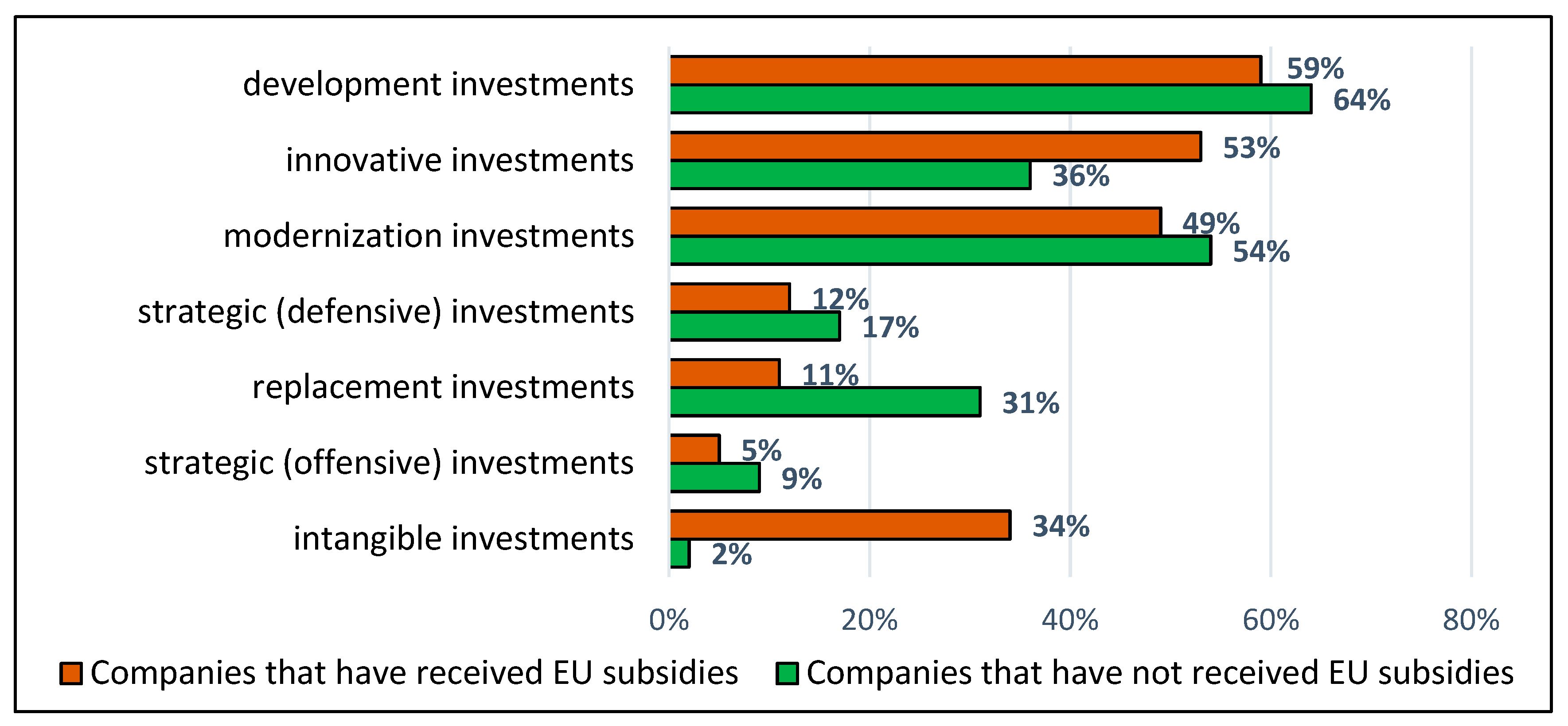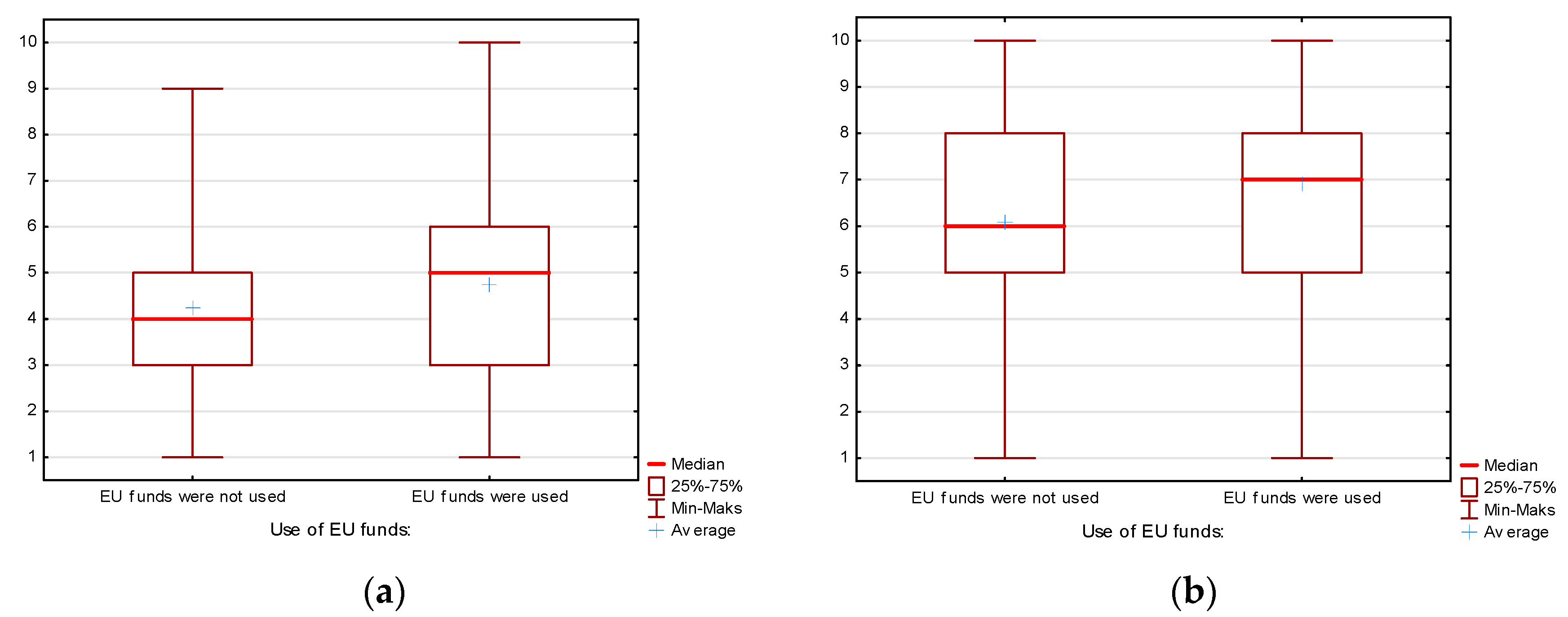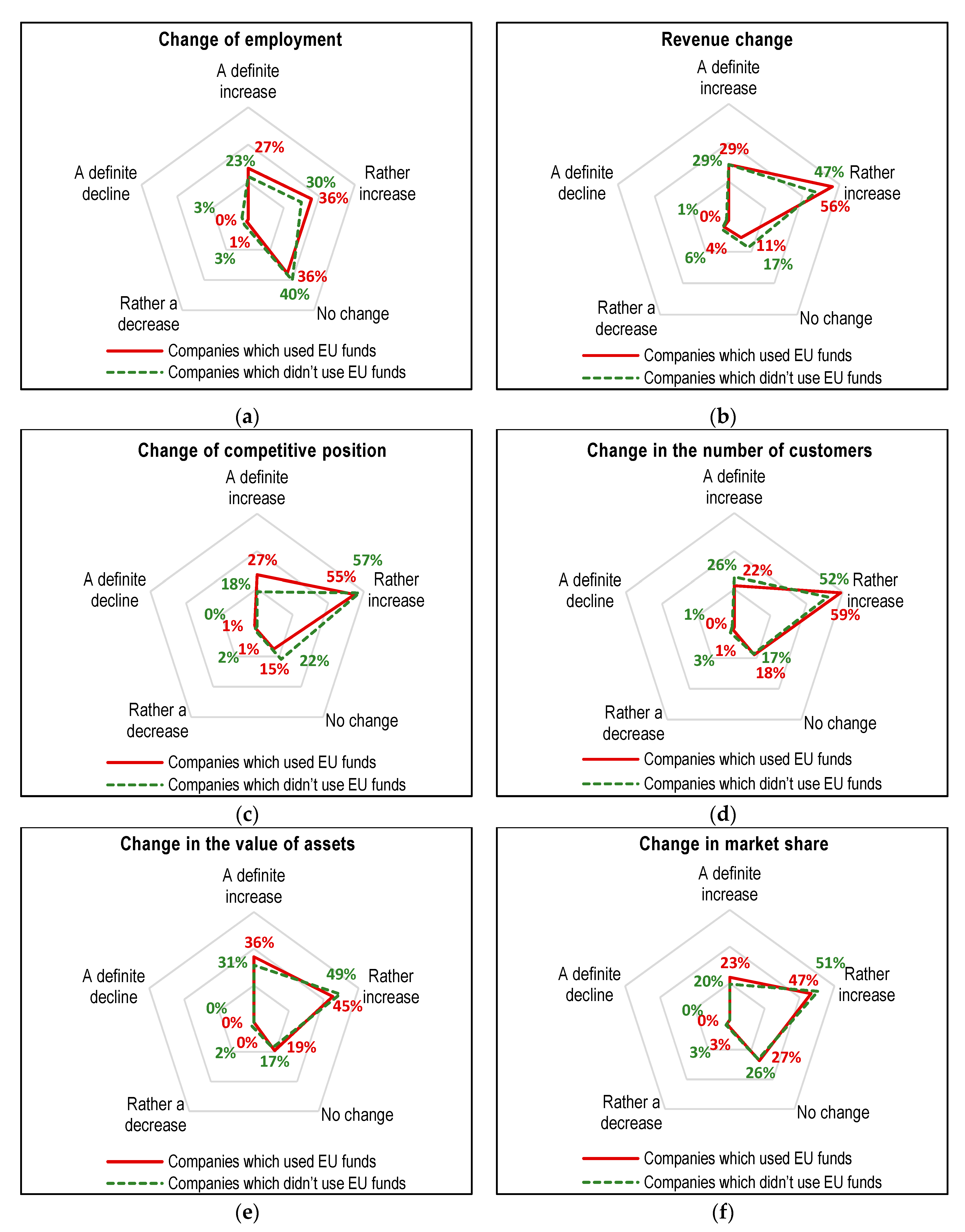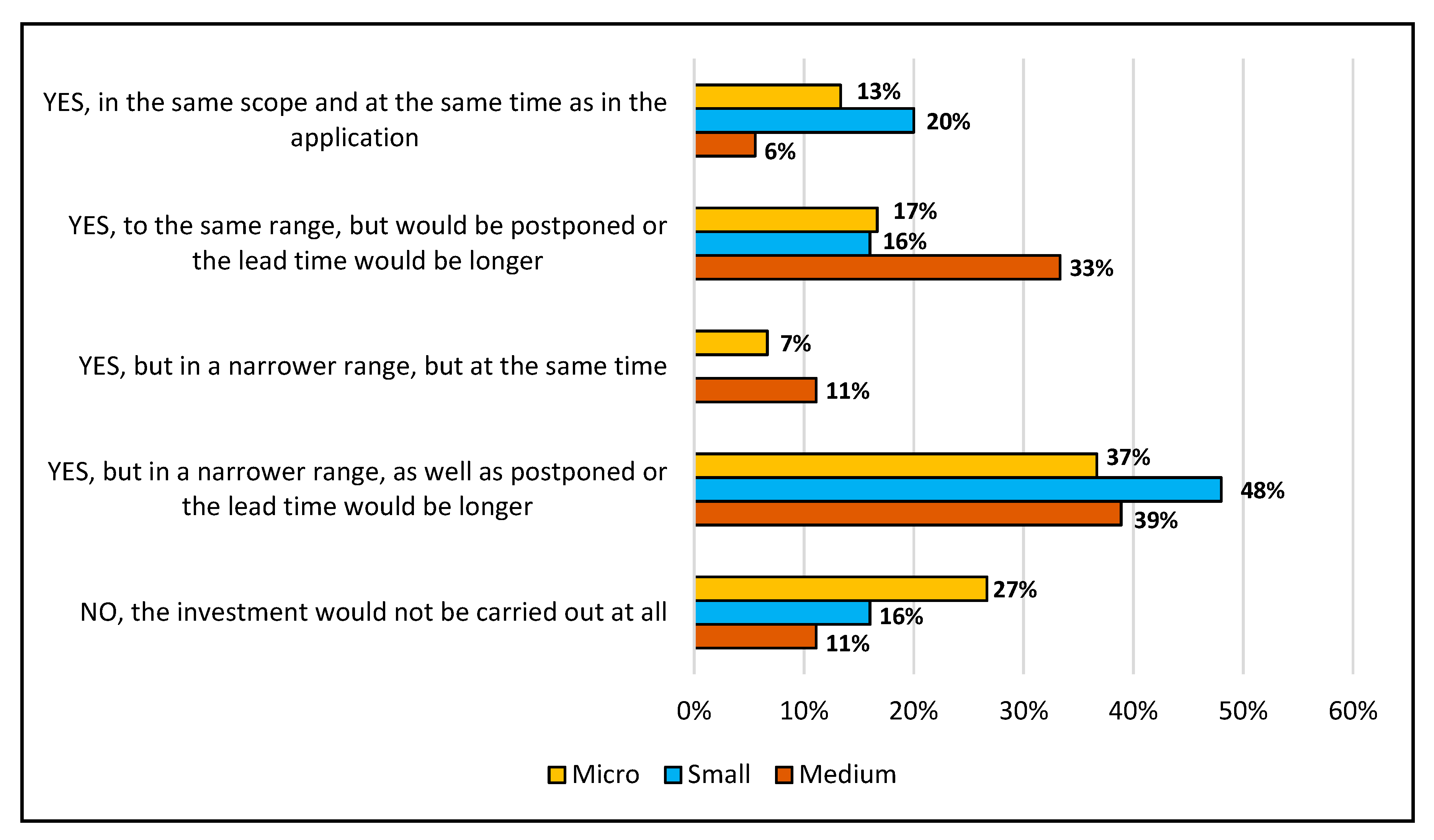Results of SME Investment Activities: A Comparative Analysis among Enterprises Using and Not Using EU Subsidies in Poland
Abstract
1. Introduction
2. Literature Review
2.1. Defining the Issue of “Investment” and Its Importance in Enterprise Development
2.2. The Importance of EU Funds in Supporting Investment in Enterprises
3. Research Methodology
3.1. Purpose and Method of Research
- single- and multiple-choice questions;
- questions based on a balanced scale (Likert scale); and
- questions using the semantic scale 0–10 in the form of tabular questions (allowing to assess the respondent’s attitude in the research area related to investments)—where, in the research on the assessment of the effects of investment activities undertaken in enterprises, the respondents used a scale from 1 to 10, with 1 indicating “insignificant position” and 10 “dominant position”.
- is the SME size (type).
- is the company revenue.
- is the market share.
- x4 is the range (space) of business activity.
- is the existence of development strategy and its length.
- is the company age.
- is the running a business in the area of advanced technologies.
- is the range (space) of innovation.
- is the observation of competitors’ activities.
- is the enterprise development phase.
- is the cooperation with business environment institutions.
- is the seeking support for investment activities.
- is the investment value.
- significance of linear regression;
- significance of partial regression coefficients;
- no collinearity (redundancy) between independent variables;
- assumption of homoscedasticity, which means that the variance of the random component (residues ) is the same for all observations;
- no autocorrelation of residues;
- normality of residue distribution; and
- the random component (residual ) has the expected value of 0.
3.2. Research Group and Research Area
4. Research Results
4.1. Evaluation of the Results of Undertaken Investment Activities
4.2. Multiple Linear Regression Model—Findings
5. Discussion and Conclusions
Funding
Conflicts of Interest
References
- Aczel, Amir Dan, and Jayavel Sounderpandian. 2018. Complete Business Statistics (Statystyka w Zarządzaniu). Warszawa: PWN. [Google Scholar]
- Albulescu, Claudiu, and Daniel Goyeau. 2013. EU Funds Absorption Rate and the Economic Growth. Timisoara Journal of Economics and Business 6: 153–70. [Google Scholar]
- Al-Tit, Ahmad, Anis Omri, and Jalel Euchi. 2019. Critical Success Factors of Small and Medium-Sized Enterprises in Saudi Arabia: Insights from Sustainability Perspective. Administrative Sciences 9: 32. [Google Scholar] [CrossRef]
- Bień, Witold. 2000. Enterprise Financial Management (Zarządzanie Finansami Przedsiębiorstwa). Warszawa: Difin. [Google Scholar]
- Borkowski, Bolesław, and Stanisław Stańko. 2010. Remarks Concerning the Application and Applying Econometric Methods in the Economic Research. Annals of Agricultural Sciences. Series G - Economy 97: 43–61. [Google Scholar]
- Borowiecki, Ryszard, ed. 2009. Measurement and Assessment of Value Creation Processes in Enterprise Efficiency Research (Pomiar i Ocena Procesów Kreowania Wartości w Badaniu Efektywności Przedsiębiorstwa). Kraków: Fundacja Uniwersytetu Ekonomicznego, p. 562. [Google Scholar]
- Bosma, Niels, and Veronique Schutjens. 2007. Patterns of Promising Entrepreneurial Activity in European Regions. Tijdschrift Voor Economische En Sociale Geografie 98: 675–86. [Google Scholar] [CrossRef]
- Bostan, Ionel, Cristina Mihaela Lazar, Nicoleta Asalos, Irena Munteanu, and Maria Gabriela Horga. 2019. The Three-Dimensional Impact of the Absorption Effects of European Funds on the Competitiveness of the SMEs from the Danube Delta. Industrial Crops and Products 132: 460–67. [Google Scholar] [CrossRef]
- Brealey, Richard A., and Stewart C. Myers. 2003. Principles of Corporate Finance. New York: McGraw-Hill Higher Education. [Google Scholar]
- Brzáková, Kristýna, and Karolína Přidalová. 2015. Comparison of Administrative Difficulties between European Funds and Investment Incentives. Procedia Economics and Finance 34: 134–41. [Google Scholar] [CrossRef][Green Version]
- Brzakova, Kristyna, and Karolina Pridalova. 2016. Comparison of Investment Costs for Companies Using EU Structural Funds and Investment Incentives. Procedia Economics and Finance 39: 711–19. [Google Scholar] [CrossRef][Green Version]
- Chandler, Alfred DuPont. 1962. Strategy and Structure. Chapters In the History of the American Indsustrial Enterprise. Boston: MIT Press. [Google Scholar]
- Churchill, Gilbert A. 2002. Badania Marketingowe: Podstawy Metodologiczne. Warszawa: Wyd. PWN. [Google Scholar]
- Connelly, Brian L., Trevis S. Certo, Duane R. Ireland, and Christopher R. Reutzel. 2011. Signaling Theory: A Review and Assessment. Journal of Management 37: 39–67. [Google Scholar] [CrossRef]
- Czauderna, Krzysztof, Jan Frankowski, Henryk Kalinowski, and Andrzej Regulski. 2016. Impact of European Funds in the Financial Perspective 2007–2013 on the Socio-Economic Development of Eastern Poland: Final Report (Wpływ Funduszy Europejskich Perspektywy 2007-2013 Na Rozwój Społeczno-Gospodarczy Polski Wschodniej: Raport Końcowy. Warszawa: Ministerstwo Rozwoju, Departament Strategii Rozwoju, Krajowa Jednostka Ewaluacji. [Google Scholar]
- Czerwonka, Leszek. 2015. Behavioral Aspects of Investment Decisions of Enterprises (Behawioralne Aspekty Decyzji Inwestycyjnych Przedsiębiorstw). Gdańsk: Wyd. Uniwersytetu Gdańskiego. [Google Scholar]
- Dorożyński, Tomasz, Janusz Świerkocki, and Wojciech Urbaniak. 2013. The Use Of EU Structural Funds By Enterprises In The Lodz Region. Comparative Economic Research 16: 79–99. [Google Scholar] [CrossRef][Green Version]
- Dubel, Przemysław. 2017. The Impact of EU Funds on the Development of Entrepreneurship after Poland’s Accession to the EU—A Review of Selected Forms of Support. University of Warsaw, Faculty of Management Research Reports 1: 135–52. [Google Scholar] [CrossRef]
- Epuran, Gheorghe, Luminita Zait, Bogdan Nichifor, and Laura Timiras. 2011. Predisposing Factors and Barriers in the Absorption of EU Funds - Conceptual and Operational Aspects. Studies and Scientific Researches. Economics Edition 16–17: 1–8. [Google Scholar] [CrossRef][Green Version]
- Fałda, Beata, and Józef Zając. 2012. The Regression Problem in Economic Sciences. Quantitative Methods in Economics 13: 82–95. [Google Scholar]
- Firlej, Krzysztof Adam. 2018. Financing Innovations by Venture Capital Funds as a Determinant of Innovativeness of Economy. Ekonomiczne Problemy Usług 132: 41–53. [Google Scholar] [CrossRef]
- Foryś, Iwona, and Radosław Gaca. 2016. Theoretical and Practical Aspects of Qualitative Variable Descriptions of Residential Property Valuation Multiple Regression Models. Cracow Review of Economics and Management 9: 89–100. [Google Scholar] [CrossRef]
- Gwizdała, Jerzy Piotr. 2017. The Financing of Small and Medium-Sized Enterprises with the EU Structural Funds in Poland Between 2014 and 2020. International Journal of Synergy and Research 6: 43–55. [Google Scholar] [CrossRef]
- Hapenciuc, Cristian Valentin, Andrei Alexandru Moroşan, and Gabriela Arionesei (Gaube). 2013. Absorption of Structural Funds – International Comparisons and Correlations. Procedia Economics and Finance 6: 259–72. [Google Scholar] [CrossRef]
- Hirshleifer, Jack. 1965. Investment Decision under Uncertainty: Choice—Theoretic Approaches. The Quarterly Journal of Economics 79: 509–36. [Google Scholar] [CrossRef]
- Huttmanová, Emilia, and Dana Kisel’áková. 2010. Support of Entrepreneurship of Small and Medium Enterprises through Financial Resources from Eu Funds. Polish Journal of Management Studies 1: 7–16. [Google Scholar]
- Igielski, Michał. 2014. Role of EU Funds in Development of Polish Companies. Contemporary Economy 5: 27–36. [Google Scholar]
- Janků, Martin. 2012. Small and Medium-Sized Enterprises in the EU and State Aids Provided for Their Support. Acta Universitatis Agriculturae et Silviculturae Mendelianae Brunensis 60: 103–8. [Google Scholar] [CrossRef]
- Jurevičienė, Daiva, and Jūratė Pileckaitė. 2013. The Impact of EU Structural Fund Support and Problems of Its Absorption. Business, Management and Education 11: 1–18. [Google Scholar] [CrossRef]
- Kalfova, Elena. 2019. Factors for Adoption of EU Funds in Bulgaria. Heliyon 5: 1–27. [Google Scholar] [CrossRef]
- Kamerschen, Dawid R., Richard B. McKenzie, and Clark Nardinelli. 1991. Economy (Ekonomia). Gdańsk: Fundacja Gospodarcza NSZZ Solidarność. [Google Scholar]
- Kamińska, Alfreda. 2010. EU Assistance Programmes as a Source of Funding for the Development and Competitiveness of the SME Sector. Barometr Regionalny 2: 51–63. [Google Scholar]
- Kończak, Grzegorz, and Magdalena Chmielińska. 2013. Zastosowanie Metod Symulacyjnych w Analizie Wielowymiarowych Tablic Wielodzielczych. Studia Ekonomiczne 133: 107–18. [Google Scholar]
- Konopielko, Łukasz, and Marta Rusak. 2017. Empirical Analysis of Entrepreneurial Grants’ Volume in the Mazovian Voivodship. Internal Trade 4: 320–29. [Google Scholar]
- Kornet, Katarzyna. 2008. European Union Funds as a Source of Financing the Companies Investments. Contemporary Economics 2: 5–20. [Google Scholar]
- Lesáková, Ľubica, Andrea Ondrušová, and Miroslava Vinczeová. 2019. Factors Determining Profi Tability of Small and Medium Enterprises in Selected Industry of Mechanical Engineering in the Slovak Republic—The Empirical Study. E+M Ekonomie a Management 22: 144–60. [Google Scholar] [CrossRef]
- Lucian, Paul. 2014. Absorption of European Funds by Romania. Procedia Economics and Finance 16: 553–56. [Google Scholar] [CrossRef]
- Lungu, Laurian. 2013. The Impact of EU Funds on Romanian Finances. Romanian Journal of European Affairs 13: 5–27. [Google Scholar]
- Maddala, Gangadharrao Soundalyarao. 2006. Introduction to Econometrics (Ekonometria). Warszawa: PWN. [Google Scholar]
- Malska, Wiesława. 2017. Wybrane Statystyki Nieparametryczne. Edukacja – Technika – Informatyka 20: 111–17. [Google Scholar] [CrossRef]
- Manikowski, Arkadiusz, and Zbigniew Tarapata. 2001. Evaluation of Economic Projects. Models and Methods (Ocena Projektów Gospodarczych: Modele i Metody). Warszawa: Difin. [Google Scholar]
- Marinescu, Nicolae. 2013. The Process of Attracting EU Funds by SMEs: Lessons From The Past. Studia Universitatis Babes Bolyai-Negotia 4: 53–67. [Google Scholar]
- Marzinotto, Benedicta. 2011. A European Fund for Economic Revival in Crisis Countries. Bruegel Policy Contribution 1: 1–10. [Google Scholar]
- McHugh, Mary L. 2013. The Chi-Square Test of Independence. Biochemia Medica 23: 143–49. [Google Scholar] [CrossRef]
- Mendes, Sílvia, Zélia Serrasqueiro, and Paulo Maçãs Nunes. 2014. Investment Determinants of Young and Old Portuguese SMEs: A Quantile Approach. BRQ Business Research Quarterly 17: 279–91. [Google Scholar] [CrossRef][Green Version]
- Michalak, Aneta. 2007. Investment Financing in Theory and Practice (Finansowanie Inwestycji w Teorii i Praktyce). Warszawa: PWN. [Google Scholar]
- Mikołajczak, Paweł. 2012. Impact of European Union Funds on the Changes in the Activities of Small and Medium Enterprises in Wielkopolska. Economics 4: 181–90. [Google Scholar]
- Mikołajczak, Paweł. 2014. Shaping Innovativeness of Great Poland Small and Medium Enterprises through European Union’s Structural Funds—An Attempt of Assessment. Internal Trade 353: 88–103. [Google Scholar]
- Mohl, Philipp, and Tobias Hagen. 2010. Do EU Structural Funds Promote Regional Growth? New Evidence from Various Panel Data Approaches. Regional Science and Urban Economics 40: 353–65. [Google Scholar] [CrossRef]
- Myers, Stewart C. 1984. The Capital Structure Puzzle. The Journal of Finance 39: 574–92. [Google Scholar] [CrossRef]
- Myers, Stewart C., and Nicholas S. Majluf. 1984. Corporate Financing and Investment Decisions When Firms Have Information That Investors Do Not Have. Journal of Financial Economics 13: 187–221. [Google Scholar] [CrossRef]
- Obłój, Krzysztof. 2007. Creating Company Strategy. In Organization Strategy (Strategia Organizacji). Warszawa: PWE, pp. 420–36. [Google Scholar]
- Opritescu, Elena Madalina. 2012. Evaluation Of The Structural Funds Absorption Rate By Means Of The Hermin Model. Annals of Faculty of Economics 1: 332–38. [Google Scholar]
- Ostrowska, Elżbieta. 2002. Risk of Investment Projects (Ryzyko Projektów Inwestycyjnych). Warszawa: PWE. [Google Scholar]
- Peszko, Agnieszka. 2014. Micro-, Small-, and Medium-Sized Enterprises Using Structural Funds. Managerial Economics 15: 97–106. [Google Scholar] [CrossRef]
- Piątkowski, Marcin J. 2010a. Building a Business Development Strategy, Taking Into Crises Situation. Research Results. Ekonomiczne Problemy Usług 585: 289–98. Available online: https://www.researchgate.net/publication/326331601_Formulowanie_strategii_rozwoju_przedsiebiorstwa_z_uwzglednieniem_sytuacji_kryzysowych_wyniki_badan_Building_a_Business_Development_Strategy_Taking_Into_Crises_Situation_Research_Results (accessed on 8 January 2020).
- Piątkowski, Marcin J. 2010b. The Role of European Funds in the Development of Innovative Enterprises. Zarządzanie i Marketing 17: 577–86. Available online: https://www.researchgate.net/publication/326332033_Rola_funduszy_europejskich_w_rozwoju_przedsiebiorstw_innowacyjnych_The_role_of_European_Union_funds_in_the_development_of_innovative_enterprises (accessed on 8 January 2020).
- Rabiej, Małgorzata. 2012. Statistics with the Statistica Program (Statystyka z Programem Statistica). Gliwice: Helion. [Google Scholar]
- Rębilas, Rafał. 2014. Financing Investments in Enterprises (Finansowanie Inwestycji Przedsiębiorstw). Warszawa: Difin. [Google Scholar]
- Reilly, Frank K., and Kieth C. Brown. 2011. Investment Analysis and Portfolio Management. Florence: Cengage Learning, Inc. [Google Scholar]
- Rogowski, Waldemar. 2011. Methodology of Project Evaluation: Principles and Benefits of Investment Project. Prace Naukowe Uniwersytetu Ekonomicznego We Wrocławiu 172: 184–94. [Google Scholar]
- Rogowski, Waldemar, and Andrzej Michalczewski. 2005. Risk Management in Investment Projects: Currency Risk and Interest Rate Risk (Zarządzanie Ryzykiem w Przedsięwzięciach Inwestycyjnych: Ryzyko Walutowe i Ryzyko Stopy Procentowej). Warszawa: Oficyna Ekonomiczna Grupa Wolters Kluwer. [Google Scholar]
- Rosłon, Jolanta, and Daniel Ciupiński. 2014. Investments as a Determinant of the Development of Enterprises. Journal of Management and Finance 12: 183–94. Available online: http://zif.wzr.pl/pim/2014_3_1_11.pdf (accessed on 8 January 2020).
- Rówińska, Małgorzata. 2012. Short and Long Term Investments (Długo- i Krótkoterminowe Inwestycje). In Financial Accounting Taking into Account IFRS (Rachunkowość Finansowa z Uwzględnieniem MSSF). Warszawa: PWN, p. 67. [Google Scholar]
- Różański, Jerzy. 2006. Material Investments and Mergers and Acquisitions in the Enterprise (Inwestycje Rzeczowe Oraz Procesy Fuzji i Przejęć w Przedsiębiorstwie). In Material and Capital Investments (Inwestycje Rzeczowe i Kapitałowe). Warszawa: Difin, p. 13. [Google Scholar]
- Siegel, Sidney, and John N. Castellan, Jr. 1988. Nonparametric Statistics for the Behavioral Sciences. New York: McGraw-Hill. [Google Scholar]
- Sierpińska, Maria, and Tomasz Jachna. 2009. Company Assessment According to Global Standards (Ocena Przedsiębiorstwa Według Standardów Światowych). Warszawa: PWN. [Google Scholar]
- Skawiński, Łukasz. 2016. Support of Entrepreneurship in Poland from the European Social Fund—The Main Findings from the Research. Unia Europejska.Pl 5: 27–36. [Google Scholar]
- Spence, Michael. 1973. Job Market Signalling. The Quarterly Journal of Economics 87: 355–74. [Google Scholar] [CrossRef]
- Spoz, Anna. 2014. Significance of the EU Funds in Investments of Small and Medium-Sized Enterprises. Oeconomia Copernicana 5: 61–74. [Google Scholar] [CrossRef][Green Version]
- Standfield, Ken. 2005. Intangible Finance Standards: Advances in Fundamental Analysis and Technical Analysis. San Diego: Elsevier. [Google Scholar]
- Sudman, Seymour. 1976. Applied Sampling. Orlando: Academic Press. [Google Scholar]
- Suszyński, Cezary. 2007. Challenges at the Enterprise Level - Value Creation Imperative. In Enterprise: Value, Management (Przedsiębiorstwo: Wartość, Zarządzanie). Warszawa: PWE, pp. 88–111. [Google Scholar]
- Szreder, Mirosław. 2010. O Weryfikacji i Falsyfikacji Hipotez. Statistical Review 57: 82–88. [Google Scholar]
- Tănase, Narcisa Melania, Mihaela Caramihai (Guda), and Anca Alexandra Purcărea. 2017. Analysis Regarding the Impact of Accessing Structural Funds for RDI Projects as a Mean Tool for Sustaining and Fostering the Innovation Activities. Procedia Engineering 181: 969–76. [Google Scholar] [CrossRef]
- Tiţa, Cristina Maria (Bătuşaru), Alexandra (Vasile) Oţetea, and Mihai Aristotel Ungureanu. 2013. Operational Programmes - Tools to Combat Economic Crisis. Procedia Economics and Finance 6: 724–31. [Google Scholar] [CrossRef][Green Version]
- Van Stel, André, Martin Carree, and Roy Thurik. 2005. The Effect of Entrepreneurial Activity on National Economic Growth. Small Business Economics 24: 311–21. [Google Scholar] [CrossRef]
- Vasile, Zai Paul, and Inceu Adrian Mihai. 2015. Approaches Regarding E.U. Absorption Funds in Romania. Procedia Economics and Finance 32: 1579–89. [Google Scholar] [CrossRef]
- Vega Flores, J. M. 2008. The Impact of EU Regional Policy on Economic Growth and Convergence among Cohesion Countries: Lessons for the Central and Eastern European Countries. Madrid: Universidad Complutense de Madrid. [Google Scholar]
- Weerahandi, Samaradasa. 1993. Generalized Confidence Intervals. Journal of the American Statistical Association 88: 899–905. [Google Scholar] [CrossRef]
- Wildowicz-Giegel, Anna. 2013. Investment Priorities and the Innovation of Enterprises in Poland. Oeconomia Copernicana 4: 65–77. [Google Scholar] [CrossRef]
- Wildowicz-Giegiel, Anna, and Adam Wyszkowski. 2015. Absorption of EU Funds in the Context of Polish Enterprises Competitiveness Measured by Profitability Ratios. Oeconomia Copernicana 6: 113–23. [Google Scholar] [CrossRef]
- Wokoun, René, Petr Kolařík, and Jana Kolaříková. 2016. Evaluation of Entrepreneurs with a Focus on Operational Programme Enterprise and Innovation (OPEI). Results of a Questionnaire Survey. Economics & Sociology 9: 272–88. [Google Scholar] [CrossRef][Green Version]
- Wolański, Robert. 2013. Impact of the Financial Environment on the Competitiveness of Small and Medium-Sized Enterprises (Wpływ Otoczenia Finansowego Na Konkurencyjność Małych i Średnich Przedsiębiorstw). Warszawa: Wolters Kluwer. [Google Scholar]
- Zaman, Gheorghe, and Anca Cristea. 2011. EU Structural Funds Absorption in Romania: Obstacles and Issues. Romanian Journal of Economics 32: 60–77. [Google Scholar]
- Zaman, Gheorghe, and George Georgescu. 2009. Structural Fund Absorption: A New Challenge For Romania? Journal for Economic Forecasting 6: 136–54. [Google Scholar]
- Zieliński, Wojciech. 1998. Regression Analysis (Analiza Regresji). Warszawa: Fundacja ‘Rozwój SGGW’. [Google Scholar]
- Żołnierski, Aleksander, ed. 2008. Innovativeness 2008: The State of Innovation, Research Projects, Support Methods, Social Conditions: Report (Innowacyjność 2008: Stan Innowacyjności, Projekty Badawcze, Metody Wspierania, Społeczne Determinanty: Raport). Warszawa: PARP. [Google Scholar]
- Żuchowski, Irenausz. 2017. Using of EU Funds and Their Impact on the Competitiveness of Enterprises of the SME Sector. Europa Regionum 33: 173–83. [Google Scholar] [CrossRef]
- Żurek, Janusz. 2003. The Essence of Investments and Investment Decisions and Their Role in the Development of Enterprises. In Economics and Management of Enterprise Development (Ekonomika i Kierowanie Rozwojem Przedsiębiorstwa). Edited by Janusz Żurek. Gdańsk: Fundacja Rozwoju Uniwersytetu Gdańskiego, pp. 364–69. [Google Scholar]




| Specification | Companies Which Used EU Funds | Companies Which Did Not Use EU Funds |
|---|---|---|
| Enterprise size | ||
| Micro | 41% | 72% |
| Small | 34% | 21% |
| Medium | 25% | 7% |
| Legal forms of enterprises | ||
| Sole proprietorship | 23% | 37% |
| Civil partnership | 12% | 6% |
| General partnership | 12% | 7% |
| Limited partnership | 2% | 11% |
| Limited liability company | 47% | 37% |
| Other | 4% | 2% |
| Established year | ||
| Until 1989 | 18% | 7% |
| 1990–1994 | 11% | 12% |
| 1995–1999 | 19% | 9% |
| 2000–2004 | 12% | 21% |
| 2005–2009 | 29% | 22% |
| 2010–2013 | 11% | 29% |
| Business market range | ||
| Local (Poviat/Commune) | 12% | 12% |
| Regional (Province) | 4% | 10% |
| Domestic | 33% | 33% |
| International | 51% | 45% |
| Total (number of entities participating in the study) | 73 | 87 |
| Has the Company Received an EU Subsidy? | The Company’s Market Position Relative to Other Enterprises—before Investment | ||||
| Average | Number of Observations | Lower Quartile (Q1) | Median | Upper Quartile (Q3) | |
| No | 4.23 | 87 | 3.00 | 4.00 | 5.00 |
| Yes | 4.73 | 73 | 3.00 | 5.00 | 6.00 |
| Total | 4.46 | 160 | 3.00 | 4.00 | 5.50 |
| Has the Company Received an EU Subsidy? | The Company’s Market Position Relative to Other Enterprises—after Investment | ||||
| Average | Number of Observations | Lower Quartile (Q1) | Median | Upper Quartile (Q3) | |
| No | 6.10 | 87 | 5.00 | 6.00 | 8.00 |
| Yes | 6.89 | 73 | 5.00 | 7.00 | 8.00 |
| Total | 6.46 | 160 | 5.00 | 7.00 | 8.00 |
| Has the Company Received an EU Subsidy? | The Company’s Financial Situation—before Investment | ||||
| Average | Number of Observations | Lower Quartile (Q1) | Mian | Upper Quartile (Q3) | |
| No | 5.51 | 87 | 4.00 | 5.00 | 7.00 |
| Yes | 5.27 | 73 | 4.00 | 5.00 | 7.00 |
| Total | 5.40 | 160 | 4.00 | 5.00 | 7.00 |
| Has the Company Received an EU Subsidy? | The Company’s Financial Situation—after Investment | ||||
| Average | Number of Observations | Lower Quartile (Q1) | Median | Upper Quartile (Q3) | |
| No | 6.36 | 87 | 5.00 | 7.00 | 8.00 |
| Yes | 6.75 | 73 | 5.00 | 7.00 | 8.00 |
| Total | 6.54 | 160 | 5.00 | 7.00 | 8.00 |
| Variable | Companies that Have Received EU Subsidies | Companies that Have Not Received EU Subsidies | ||||
|---|---|---|---|---|---|---|
| Average | Standard Deviation | Coefficient of Variation | Average | Standard Deviation | Coefficient of Variation | |
| Change of employment | 3.89 | 0.83 | 21.23 | 3.66 | 0.99 | 26.98 |
| Revenue change | 4.10 | 0.75 | 18.27 | 3.97 | 0.90 | 22.57 |
| Change of competitive position | 4.10 | 0.84 | 16.97 | 3.92 | 0.70 | 17.92 |
| Change in the number of customers | 4.01 | 0.68 | 16.86 | 3.99 | 0.83 | 20.76 |
| Change in the value of assets | 4.16 | 0.73 | 17.45 | 4.09 | 0.76 | 18.50 |
| Change in market share | 3.90 | 0.78 | 20.10 | 3.86 | 0.77 | 19.81 |
| R = 0.68913359; R2 = 0.47490511; Adjusted R2 = 0.43571892 F(5,67) = 12.119; p < 0.00001; Standard Estimation Error: 1.4004 | ||||||
|---|---|---|---|---|---|---|
| N = 73 | b* | St. Error with b* | b | St. Error with b | t(67) | p-Value |
| constant term | −4.75480 | 1.520890 | −3.12633 | 0.002618 | ||
| 0.262740 | 0.122306 | 0.65445 | 0.304650 | 2.14821 | 0.035316 | |
| 0.357467 | 0.116826 | 0.84928 | 0.277561 | 3.05982 | 0.003184 | |
| 0.206428 | 0.093018 | 0.45559 | 0.205293 | 222 | 0.029862 | |
| 0.208257 | 0.097434 | 0.91223 | 0.426788 | 2.13742 | 0.036217 | |
| −0.262186 | 0.098419 | −0.89090 | 0.334425 | −2.66397 | 0.009664 | |
| R = 0.70619168; R2 = 0.49870669; Adjusted R2 = 0.48058766 F(3,83) = 27.524; p < 0.00001; Standard Estimation Error: 1.7151 | ||||||
|---|---|---|---|---|---|---|
| N = 87 | b* | St. Error with b* | b | St. Error with b | t(67) | p-Value |
| constant term | −6.08729 | 0.850263 | −7.15931 | 0.000001 | ||
| 2 | 0.614001 | 0.080243 | 1.63253 | 0.213353 | 7.65177 | 0.000000 |
| x5 | 0.159690 | 0.079975 | 0.41468 | 0.207677 | 1.99674 | 0.049131 |
| x8 | 0.155999 | 0.078420 | 0.18953 | 0.095278 | 1.98927 | 0.049965 |
© 2020 by the author. Licensee MDPI, Basel, Switzerland. This article is an open access article distributed under the terms and conditions of the Creative Commons Attribution (CC BY) license (http://creativecommons.org/licenses/by/4.0/).
Share and Cite
Piątkowski, M.J. Results of SME Investment Activities: A Comparative Analysis among Enterprises Using and Not Using EU Subsidies in Poland. Adm. Sci. 2020, 10, 4. https://doi.org/10.3390/admsci10010004
Piątkowski MJ. Results of SME Investment Activities: A Comparative Analysis among Enterprises Using and Not Using EU Subsidies in Poland. Administrative Sciences. 2020; 10(1):4. https://doi.org/10.3390/admsci10010004
Chicago/Turabian StylePiątkowski, Marcin J. 2020. "Results of SME Investment Activities: A Comparative Analysis among Enterprises Using and Not Using EU Subsidies in Poland" Administrative Sciences 10, no. 1: 4. https://doi.org/10.3390/admsci10010004
APA StylePiątkowski, M. J. (2020). Results of SME Investment Activities: A Comparative Analysis among Enterprises Using and Not Using EU Subsidies in Poland. Administrative Sciences, 10(1), 4. https://doi.org/10.3390/admsci10010004





